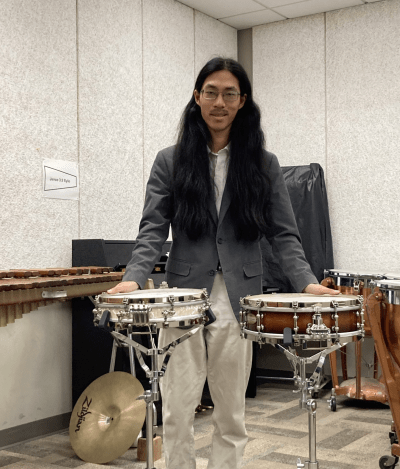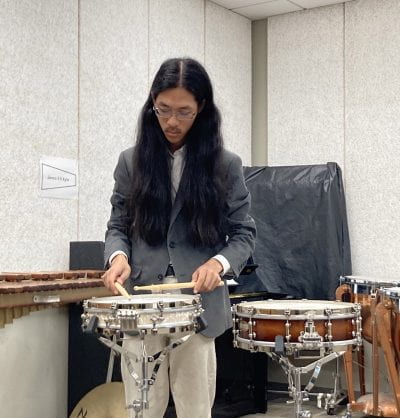Yoshio Yamashita is a fourth year Honors College Fellow from Russellville, Arkansas, studying music composition. Since fall 2020, he has been writing and arranging percussion ensemble pieces to accompany the snare drum suite Douze Etudes pour Caisse-Claire (Twelve Etudes for the Drum) by Jacques Delecluse which is a cornerstone of percussion pedagogy. This fall, he performed a selection of his pieces at a recital in the Faulkner Performing Arts Center.
 1. What drew your interest to having percussion and the Twelve Etudes be the focus for your honors thesis?
1. What drew your interest to having percussion and the Twelve Etudes be the focus for your honors thesis?
I’m a music composition major and percussion is my applied instrument. The Twelve Etudes for the Drum, which my pieces correspond with, are common preparatory studies for students to see at the college level. They’re introduced during college and then can be found throughout most professional settings: They’re popular selections for juries, recitals and graduate school auditions. If you’re going to be a professor somewhere or you’re getting a job at a symphony or orchestra in percussion, you’ll probably be asked to play one of these.
Before I started considering this project for my honors thesis, it was just something to keep me busy during lockdown. I had started studying Etude Number One when I became familiar with the work of percussionist Pablo Rieppi who teaches at the Juilliard School, and who created piano accompaniments for the Etudes. These accompaniments were meant to help students feel like they weren’t just playing snare drum studies and bored to death if they weren’t super interested in those. My thesis mentor, professor Chalon Ragsdale encouraged me to try writing something like this as well.
The composer of the Twelve Etudes, Jacques Delecluse, taught at the Paris Conservatory, and most of his students went into jobs playing in professional orchestras. He wrote these as preparatory studies for playing with other musicians. With that in mind, I started writing my pieces with the intention of having students experience these etudes from the perspective of playing with other people and being musically sensitive as part of an ensemble.
2. Can you explain what an etude is, or what makes it unique from other solo musical compositions like a concerto or a sonata?
Etudes are musical studies that are intended for student performance in either examinations or auditions. In the past, you would learn them for your music lessons and played them for your teacher, and that was about it. There were a lot of etudes written around teaching students one particular technique, and so you would use this one technique for the entirety of the etude and no other technique. With a concerto or sonata, which is a piece that you would maybe play in a recital, that might have all kinds of different techniques in it. The Twelve Etudes in particular are primarily audition material, so it’s not uncommon to go for an orchestra audition and see one of these on the list.
 3. What was your creative process for composing your ensemble pieces?
3. What was your creative process for composing your ensemble pieces?
The Twelve Etudes for the Drum are fairly complex, both rhythmically and formally. Musical form is something we communicate primarily with harmony. Most music textbooks will tell you that this part of form is delineated by a harmonic shift like a key change or a time signature change. The snare drum is relatively incapable of expressing multiple harmonies, though, since it basically has one pitch. Expressing melody is therefore pretty difficult to do, especially if you’ve never been asked to do that before on a snare drum.
The first part of my composition process was looking at each etude and figuring out where to break it up into sections–where does this part end, and where is the beginning of the next part? So breaking down the form was the first part of it, and once I had the form, I would write in elements to denote a new section. I would build up to a key change to tell the audience, “Hey, something new is happening here.” Then, I would take all the rhythms and the rests from the original Etudes and figure out what rhythmically needs to be going on in my pieces to create something interesting for an ensemble learning the Etudes.
The pieces I’ve written for percussion ensemble are built around the formal and rhythmic complexity of the etudes. They have the rhythmic complexity, but they also add on harmonic and formal complexity so the performers have something to grasp onto so they can tell what the etudes are doing now. It’s really a more immersive and educational experience. I also wanted to create pieces that you can take the snare drum part away from completely, and they’re still musically-fulfilling pieces for percussion ensemble. As a result, they are standalone pieces that, incidentally, line up with Twelve Etudes for the Drum by Delecluse.
4. Did this experience composing impact your post-college plans?
I’m completing a composition degree, but I’m also planning to pursue a graduate degree in orchestral conducting, which is kind of a completely different avenue than playing percussion and writing music. Composition is something I can continue with or without a master’s degree in it. There are plenty of examples of conductors who have been composers. While I don’t foresee myself going into any audition circuit or job circuit where I will have to play these etudes, I do think I would I have a little bit of a leg up on people who have, say, never studied these before.
In terms of my plans after graduation, there’s the possibility that I can publish these pieces and, you know, maybe make a little name for myself in the percussion community, maybe get a publishing deal down the road. Professor Ragsdale, who’s much more versed in percussion pedagogy than I am, thinks that this project could be a pretty important part of the percussion pedagogy and the culture of teaching these etudes to students, should enough teachers latch on to the fact that, hey, this is something that helps a lot. We’ve seen pretty good results with it with the students we’ve worked with here.
5. How did you get involved in percussion?
I’ve been playing music since I was five when I started playing cello. When I got to sixth grade, the public schools didn’t have an orchestra program, and they said I would have to join the band or choir to be in the music program. I wasn’t very interested in choir, though, and so for whatever reason I chose percussion and kept doing it through high school. I applied here, and after a couple of emails back and forth, they said I should join the band so they can get a scholarship. I did, and I ended up studying with Professor Ragsdale. Really, most of it’s been by chance more than anything. My progression throughout high school percussion really wasn’t something I was super invested in because we didn’t have any percussion teachers in band. It’s been mostly circumstance that’s pushed me into some beneficial opportunities–a lot of being in the right place at the right time. As a high schooler, I don’t think I don’t think I would have envisioned myself where I am right now.
